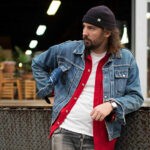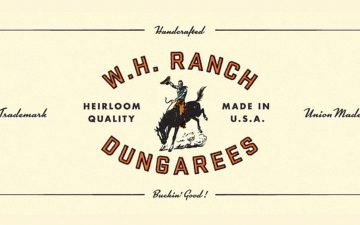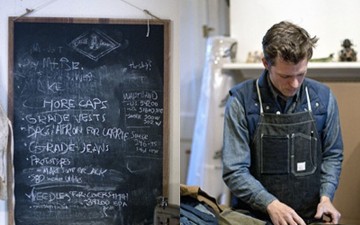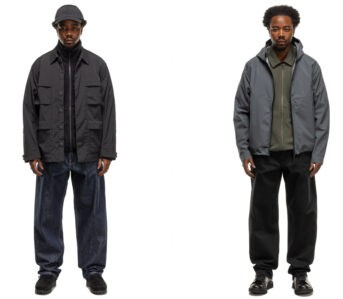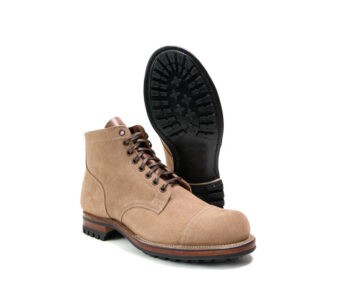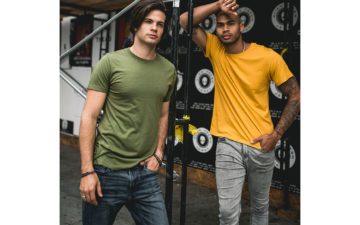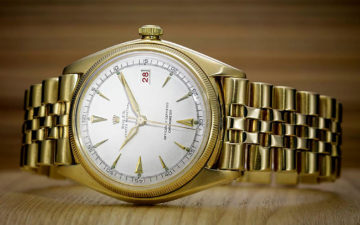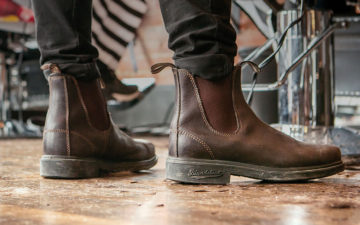Have you ever run your hand along a rack of shiny green flying jackets at a vintage store? Have you seen a fighter pilot or ground crew on leave? Have you seen the movie Top Gun (or the sequel)? Then you’ve encountered a jacket Jeff and Jacky Clyman had a hand in creating.
The husband and wife team have been producing and reproducing some of the most iconic American military outwear for nearly 50 years. Today, we’re looking at Jeff and Jacky’s brand Cockpit USA, the label that started as an homage to military aviation history and ended up becoming a part of it.
Taking Off

595 Broadway – the first Cockpit USA Store in 1986.
It seemed fated that Jeff would enter the world of aviation. His father started flying in 1932 as he barnstormed throughout Pennsylvania farming communities, doing stunts in his biplane and charging locals for airplane rides.
As the U.S. was pulled into World War II, his prior flying experience would make him a novice pilot in the U.S. Army Air Forces. He flew with squadrons of Army Air Forces over Burma and China and later B29 bombers over Japan. His uncle joined as an air cadet and ended up in a P47 fighter squadron escorting bomber planes over Europe.
Some years later, Jeff learned to fly wearing his dad’s old A-2 Army Air Force flight jacket from WWII. Jeff was flying in historical air shows in the early 1970s and many attendees offered to buy the jacket off his back. He’d never part with it, but when it went missing, the wheels started turning for how finite the supply was for these pieces of history.
Enter Avirex

Jeff in the Cockpit production room today.
Over the next few years, Jeff and his wife Jacky amassed a collection of A-2, B-3, and G-1 jackets among others from WWII, both for personal interest and with the goal of reproducing them.
In 1975, they debuted Avirex, their label “…dedicated to the continuation of the apparel made famous in WWI and WWII.” This makes Jeff and Jacky some of the earliest pioneers in midcentury repro clothing, this was a full decade before Studio D’Artisan debuted Japan’s first pair of repro jeans.
After the war, there was very little posterity for preserving the designs and manufacturing techniques for the future. Much of the work was reverse engineering and painstakingly deconstructing how a jacket was put together in their small Park Avenue South three room office in New York City.
One such technique was recreating a finish on sheepskin jackets, as Jeff tells it:
I went down to Texas to the tannery we were using at the time and stayed for three weeks working with the chemist trying to develop as close a finish as what I saw on the jackets I had in my collection. What came of that was a finish that appeared solid but as you wore it, it cracked and looked as distressed as the then 30+ year old jackets we used as samples. That finish is what you now see everywhere on the many versions of “bomber” jackets you can purchase all over the world!

They sold directly to other enthusiasts, but within a few years, other retailers wanted to stock Avirex garments. They created the Cockpit catalog in as a way to separate the wholesale from the direct to consumer business, they still produce them every season and you can see recent issues of the Cockpit USA catalog here.
These publications became collector’s items in the historical aviation community and attracted the interest of Hollywood.
Cockpit on the Silver Screen

As mentioned, the world of historical aviation is rather small, and when movie studios wanted to get the look right they called the number on the Cockpit catalog. In 1980, that was for The Right Stuff, and the Clyman team produced flight suits for the film’s opening in Washington D.C.
But the one I’m guessing you know best is THE flight jacket movie—Top Gun. As Jeff remembers:
In 1984 and 1985, we had begun using a distressed lambskin replica of the USN G-1 in the commercial market with insignia patches and a lining with a replica of a WWII escape map. Coincidentally, we were approached by Paramount in late 1985 to start to publicize the upcoming film called TOP GUN in our mail order catalog (no internet). It was a natural fit and worked out well for both Paramount and our company. We then licensed the movie logo TOP GUN for a short time and the rest is history.

Tom Cruise and Kelly McGillis in Top Gun (1986).
They make a replica stitch-for-stitch patched jacket you see on screen in the original movie as well as the sequel Top Gun: Maverick in 2022, which they also still sell on their website along with a variety of other Top Gun apparel.
Through today, Cockpit has continued to be a source for authentic outerwear.

Movie Hero® Top Gun Navy G-1 Jacket, available for $990 at Cockpit USA.
A-2 Historian to A-2 Supplier
But Jeff and Jacky have provided jackets to more than just on-screen pilots.
In 1980, a new employee joined the Avirex team whose family had actually made A-2s, B-3s, as well as a variety of sheepskin and textile jackets used by the Army Air Forces and the Navy during WWII. He had experience with bidding on government contracts for some of the same jackets they were already reproducing.
This is how they came to make tens of thousands of spec jackets for the USAF, NASA, DARPA and other agencies including the CWU 45/p that was produced in 1984 and I’ve worn for the better part of the last decade. They still make versions of it in nylon and the spec fire-retardant Nomex.


My CWU 45/p with AVIREX LTD. label.
These relationships helped foster one of Jeff’s lifelong dreams, an official reissue of the A-2 flight jacket by the U.S. Air Force. I’ll let him tell the story:
The U.S. Army Air Forces discontinued issuing leather flight jackets at the end of 1943. I had contacted the various Air Force offices that were involved in uniforms but no one was interested until ONE DAY in 1987. The powers that be in the U.S. Air Force decided that to boost morale and compete with the U.S. Navy [remember, Top Gun was about Navy pilots], which had never relinquished their issuance of leather flight jackets going back as far as 1938, they would reissue the A-2.
I finally contacted the appropriate division in the Air Force and coincidentally they were interested in the project and assigned a Lt. Colonel to spearhead the project with us. We submitted various types of leathers and the USAF actually adopted our commercial reproduction pattern as the first contract pattern and jacket using seal brown colored goatskin which was what we were using on our jackets.

Their USAF spec A-2 jacket, available for $550 at Cockpit.
All the while, we were still producing DuPont fire retardant Nomex cloth flight jackets for the USAF [like my CWU above] which had adopted this garment in the mid 1970s after phasing out the iconic MA-1 sage green nylon flight jacket with the orange lining.
We produced the first 200 re-issue flight jackets for the USAF. After that, while we were still producing other hi-tech flight jackets and gear for the USAF, NASA, and DARPA, another company obtained the contract by bidding very low. We didn’t return to producing the A-2 jacket using goatskin until 1998. The US Air Force changed their specification for the A-2 jacket sometime in the mid 2000s switching to cowhide printed to simulate goat. This was because there was a shortage of goatskin in the US and the A-2 spec required by then that all the leather used had to be from animals born and bred in the United States.
For more than 25 years, Cockpit has been the USAF supplier for A-2 jackets, and you can find the same spec jacket on their website.
Airfields of Dreams

If you’ve ever wondered how the Cockpit USA model imagery can feature models in and around historic fighter planes, in 2000, they decided they wanted to expand their aviation preservation efforts beyond just the apparel, and opened the American Airpower Museum on Long Island.

The museum features exhibits and vintage military aircraft that still regularly fly for museum visitors. Jeff hopes, “The museum demonstrates the kind of communal values to do whatever it takes to get the job done – whether in conflicts or in contributing to the good of the community.”
Cockpit Today

Jeff and Jacky sold Avirex in 2006 but continued to offer the same quality made in USA, jackets and apparel under the Cockpit USA label. In addition to flight jackets like G-1s, A-2s, and B-3s, they also produce:
- Classic field jackets like the M-43, M-51, M-65
- N1 Deck Coats
- Varsity jackets
- Motorcycle jackets
- The classic 1920s American workwear label Pay Day and have reproduced several of their key pieces in deadstock White Oak denim
They also continue to honor their promise for lifetime repairs on all Cockpit products (and Avirex ones made while they still owned it), so you can rest assured any purchase will last as long as it’s repairable.


What started with one lost A-2 jacket over 50 years ago has lead to tens of thousands more in the world today. Have a look at their website and learn more about getting your own piece of history.
